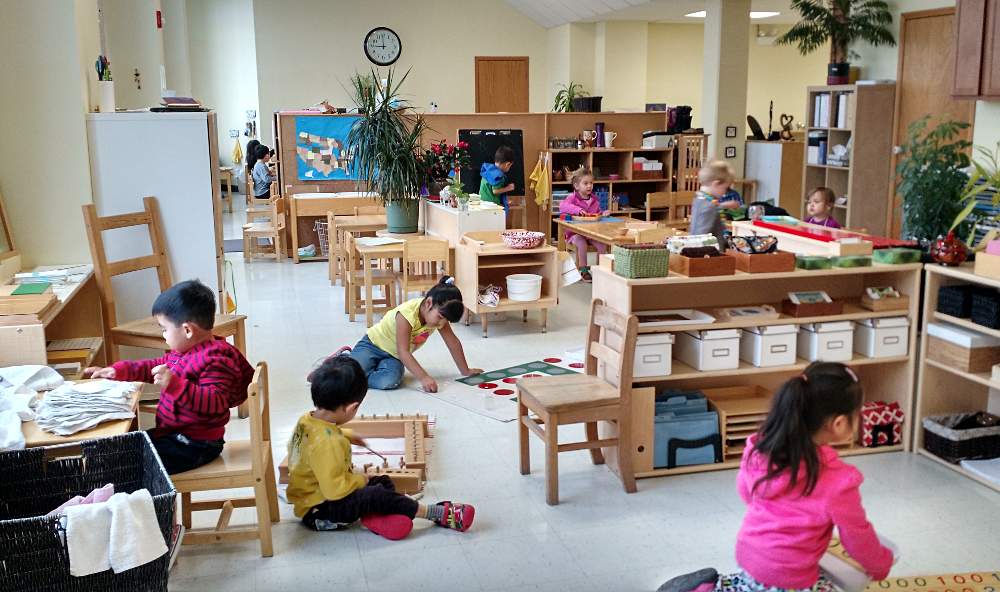Montessori is a method renowned for being flexible, independent, and a self-directed form of learning. This may be what you have heard, but what does the Montessori curriculum actually look like? Here are a few things you ought to know.
The Montessori curriculum helps children to focus on five key areas of study. These include Practical Life, Sensorial, Mathematics, Language, and Culture. These areas are put together with a set of teaching materials that are designed to increase in complexity as the child grows and matures.
As you might know, the Montessori classroom is meant to support self-directed and individual learning. Children are grouped by varying age groups which allows older students to work with younger students. Read on for more in depth information on the Montessori curriculum!
Characteristics of the Montessori Curriculum
A Montessori classroom should be fun and engaging but it should also be a place where serious work is taught and experienced. Let’s talk about some main characteristics of the Montessori curriculum.
As said before, a Montessori classroom is always focused on independence. While the curriculum does provide a classroom with structure, it greatly encourages students to choose their own activities and focus on learning in their own way. This approach will increase not only independence in children, but will also instill in them a mature outlook on life and the way they accomplish things.
Unlike most other schools, the Montessori curriculum does not encourage the memorization of information. It is not believed that memorizing information impacts a child’s ability to learn in a positive or even needful way. Instead, Montessori teachers (or guides as they’re often called) will help a child to follow the curriculum in a hands-on way that will help the child to retain the lessons taught in the classroom.
Children, rather than teachers (or guides) direct the learning process in the Montessori classroom, a characteristic that sets Montessori apart from other schools and curriculums. Rather than be confined to the same thing and learning it in the same way, students who study the Montessori curriculum will be allowed to move at their own pace and move on from one skill if they are ready (regardless of age). Teachers/guides will observe and help and direct where needed, but they will not interfere with a student’s learning process.
Lastly, the Montessori curriculum is strongly focused on early childhood development. Based on a series of developmental research, the most critical and formative years in a child’s life most often take place before they reach the age of six. That being the case, the Montessori curriculum makes a point of emphasizing early development and learning.

What Are the Subjects in a Montessori Curriculum?
In addition to the five main areas of practical life, sensorial, math, language, and culture, additional subjects taught in a Montessori curriculum include geography, science and nature, music, art, and physical education. Secondary levels (middle through high school) in most Montessori schools offer additional subjects such as foreign languages, technology, environmental studies, and economics.
What Does Montessori Curriculum Look Like?
Each of the above subject areas in the Montessori curriculum are prepared with different tools and learning materials that will become more and more complex/difficult to use as the children grow. Let’s take a look at each of these areas individually, shall we?
Practical Life
Something that makes the Montessori way a unique one is that it teaches practical life skills that a student would be likely to observe daily. The practice of these activities not only helps a student prepare for practical life but also helps them to develop and fine-tune their basic motor skills. The lessons taught in the practical life area include things like cleaning, transferring, preparing food, and lessons in grace and courtesy. For example, students might learn pouring, sewing, sweeping, and other things of a similar nature.
Sensorial
As you have probably guessed from the name, the sensorial area focuses on helping students to refine their senses of sight, touch, smell, taste, and sound. This will help them to organize their sensory impressions as well as their understanding of the world. Materials like the trinomial cube, pink tower, geometric solids, and color box will help students to gain and perfect their understanding.
Mathematics
You guessed it; mathematics is all about math. This area of the curriculum focuses on teaching and helping students to understand abstract mathematical concepts and relationships. As with most of the Montessori experience, mathematics is taught in a completely hands-on way. Using things like a teens board, hundreds board, hanging bead stair, and numerals and counters, children will be able to visualize equations and problems and come to a greater understanding of them and how they work.
Language
This portion of the Montessori curriculum focuses on providing children with the knowledge and skills to develop and build their understanding of language and vocabulary. Hands-on materials like sandpaper letters, moveable alphabets, and three-part cards are used to help children develop the skills that are required for oral language, reading, and writing. Students are also able to learn phonics and letter identification in this way.
Culture
It’s called culture studies (or humanities), but this area actually encompasses a lot of things, including botany, history, art, and several others that can help students to come to an understanding of different cultures. This part of the curriculum is quite possibly one of the most important because it helps students to gain an understanding of their community and all the other communities in the world.
Geography, Science & Nature
Though not one of the five main areas of Montessori curriculum, geography, science, and nature are featured prominently in Montessori schools. Science and nature are easily taught, as a child’s natural curiosity will take hold and direct them through the learning process. Plant and animal kingdoms are studied and plenty of time is given for the student to spend outdoors exploring nature and all she has to offer.
Geography is also focused on in a hands-on way. The use of maps, blocks, and globes is employed to help children become familiar with the layout of the land.

Other
Additional subjects taught in Montessori schools will vary by age group and from school to school. But most Montessori secondary programs will incorporate subjects that include physical education, technology, foreign languages, environmental studies, and economics. As with the other Montessori subjects, these are taught in a practical and hands-on way. For example, an economics area of study may involve students actually starting their own entrepreneurial venture where they form a business plan and create hand-made products to sell.
Needless to say, if you choose to enroll your child in a Montessori school, they will receive a fairly well-rounded education.

